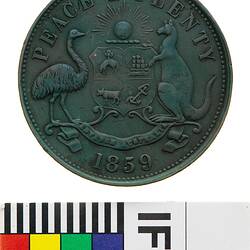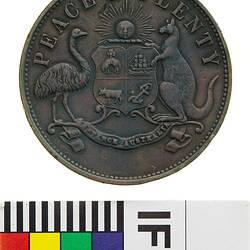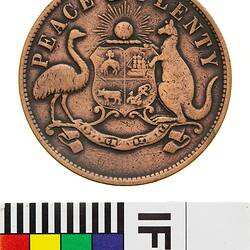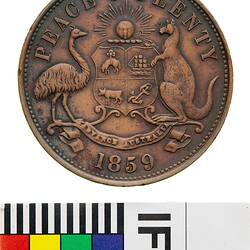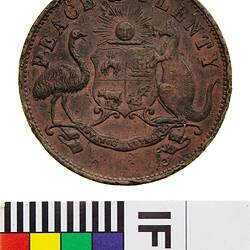Heaton and Sons is one of the longest running and most prolific private mints in the world. The company began as a family business in Birmingham, then a booming metal working centre, pioneering the mass production techniques of the industrial revolution. In 1794 Ralph Heaton I established a brassfounding business in Slaney Street, Birmingham. From 1808-1812 the company moved to Shadwell Street. During that time Heaton's son Ralph Heaton II became apprenticed to Thomas Willetts as a die maker.
By 1817 Ralph I gave Ralph II a tenement and shop at the corner of Bath Street and Shadwell Street. Although the two men shared an address, they separately administered their businesses. 1817 marks the birth of the business in question, which endured for nearly two centuries. In 1847 Ralph II's business became Heaton and Son, when Ralph III joined his father. In 1853 the business became Heaton and Sons when George began with them. This name was retained until 1889.
In 1850 Ralph II purchased equipment from the wound-up Soho Mint, also of Birmingham. The equipment was moved to the Bath Street premises. The first issue from the mint was the 1851 Annand Smith (Sydney, New South Wales) penny token.
Between 1850 and 1875 Heaton and Sons struck at least two Australasian tokens; the above, and one Iredale & Co. token both bear their "H" mintmark. Andrews ascribes 17 Australasian tokens to Heaton and Sons, based on similarities of design and manufacture to the Iredale & Co. token. A total of 25 tokens are ascribed to the company by J.O. Sweeny, but he suggests that more tokens may have been struck from dies made by Heaton and Sons or that both the dies and tokens for a larger number were made by the company (Sweeny, J.O., A Numismatic History of the Birmingham Mint, Birmingham, 1981, Appendix VI: Australiasian Tokens, pp.240-245).
In 1851 Heaton and Son began producing currency for the Royal Mint, and for other nations, making coins in various denominations for the Republic of Chile. From this time forward the production of coins for export became an important, if not the most important, part of their activities. In 1860 a site was purchased in Icknield Street, Birmingham; the business relocated there two years later. The proprietorship of another generation, Ralph Heaton III, then began.
In 1887 Heaton and Sons won a contract to build and equip the Canton Mint. Two years later, on 22 March 1889, the company became a limited liability company. The company name was changed from Heaton and Sons to "The Mint Birmingham Limited". Ralph Heaton III retired with the proviso that his son, Ralph Heaton IV, be taken on as General Manager. Heaton III died in 1891.
In 1911-1912 the Birmingham Mint lost its monopoly with Royal Mint coinage. Henceforth it had to share contracts with Kings Norton Metal Company, which in 1918 became part of Nobel Industries. Between 1910-1915 several Australian bronze and silver coins bore the 'H' for Heaton mintmark. These include Australian silver shillings dated 1910-1915. In 1919 the company made its last issue with Heaton "H" mark.
Ralph Heaton IV retired in 1920. Mr W.E. Bromet, the husband of Heaton's sister Constance, succeeded him as Managing Director.
In the 1930s Ralph Heaton V was appointed Secretary to the company, the last of the Heaton family to be steward of the company. In 1964 a bidding consortium was established between the Royal Mint, Birmingham Mint and Kynoch Mint to produce coins for export.
In 1968, the discovery of a box of cardboard impressions from the archives of Ralph Heaton & Sons determined that one hundred issues, attributed by Andrews to William Taylor and the Port Phillip Kangaroo Office, were actually manufactured in Birmingham by Heaton & Sons.
In 1988 Birmingham Mint purchased Green Duck Corporation in USA. The Birmingham Mint Group restructured into four divisions. Three years later, in 1991, IMI (formerly Kynoch Mint) acquired a controlling interest in Birmingham Mint Group after a contested take-over bid. IMI Mint subsequently moved to Birmingham Mint site and changed the company name changes to IMI Birmingham Mint Ltd. In 1993 the company purchased Casino Tokens Inc. USA.
In 1998 the company name reverted back to "The Birmingham Mint Ltd". The following year the American subsidiaries of the company were closed down. In 2000 Birmingham Mint Ltd secured its biggest ever-single order, over £45 million Sales Value, to supply German Mints with 1 & 2 Euro Coin Blanks. It struck 50 million 2 Euro coins for another European National Mint. The following year the company was sold to former CEO. Roland Vernon and colleagues, and in 2003 it was acquired by JFT Law & Co Ltd and Stirchley Machine Tools Ltd.
The Birmingham Mint closed in 2003.
References:
Sweeny, J.O., A Numismatic History of the Birmingham Mint, Birmingham, 1981, Appendix VI: Australiasian Tokens
https://coinsweekly.com/the-rise-and-fall-of-a-private-mint-the-birmingham-mint/#:~:text=Because%20of%20acute%20cash%20deficiency,2003%2C%20the%20Birmingham%20Mint%20closed. - accessed Oct. 2023.
The letter book, ledgers, journal, cash and wages books from Ralph Heaton & Sons 1840-88 are held in the in Britain's National Register of Archives - accession number GB/NNAF/B10500.
More Information
-
Keywords
-
Localities
-
Authors
-
Article types

